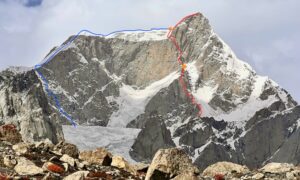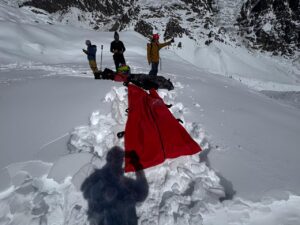When you think about unclimbed 6,000m peaks in Nepal, you probably think of the imposing domain of elite alpinists. Yet with a little ingenuity, the Himalaya offer plenty of opportunities for climbers of all levels.
Matt Powell, who considers himself a “medium-level climber,” looked for a peak that was unclimbed and yet straightforward. He found it in the wild northwest of Nepal.
“I’ve had the ambition to make the first ascent of a Himalayan mountain and I’ve done a lot of research,” Powell explained.
Looking for the right choice
“There are many lists of unclimbed peaks and most of them are inaccurate. However, by looking at different sources I found a peak which looked pretty straightforward in an area that was interesting because it is well off the beaten track,” Powell said.

There are still places to trek in solitude in Nepal, such as the valleys leading to Chandi Himal. Photo: Matt Powell
It took Powell several attempts to actually get to Nepal because of COVID closures. The peak was unclimbed because it is not easily accessible.
“People don’t care to trek a week just to get in front of the mountain,” he said.
Old-fashioned adventure
To find climbing partners, Powell posted an ad with the Potomac Appalachian Trail Club of Washington, D.C. Kevin Bialy responded and recruited his friend, Jaime Iranzo (a Spaniard who was completing his studies at university).
In the build-up to their expedition, disaster struck. Powell was hit by a truck while cycling. From that day, he only hoped to recover enough to get to Nepal. In 2021, he accomplished his goal and finally made it to the mountain. Once in country, the team hired Pemba Sherpa, a native of the Humla district, who knew the valley inside out.
“Our local agency put everything together and we moved with 12 supporting crew and 16 mules, so it was a full-fledged expedition,” Powell said.

Expedition team at base camp. Climbers Kevin Bialy (U.S., extreme left in black parka), Matt Powell (U.S., center, in orange parka), and Jaime Iranzo (Spain, second from the right in a red hat). Photo: Matt Powell
The team arrived in Kathmandu on April 29 and flew to Nepalgunj on May 1. After a three-day rain delay, they flew to Simikot on May 5.
The nine-day trek from Simikot was easy, scenic, and quiet.
“We never crossed paths with another human soul, but we saw snow leopard footprints,” Powell said. “Jaime [Iranzo] had some problems acclimatizing at first, but as the days went by, he got stronger and stronger. It was a real wilderness experience, which was what I was looking for.”

Mules carried the team’s gear to base camp.
A first ascent in four hours
“We had hoped to situate our base camp at 4,950m, at the foot of the couloir that leads to the foot of Chandi’s southeast ridge. However, unseasonably deep snow prevented our mules from getting that far, so we established base camp at 4,815m on May 14,” Powell said.
Next, they set up an advanced base camp at 5,365m and a high camp at 5,740m. High camp was as far as Powell could go post-crash, but his teammates continued.

Advanced base camp at the foot of Chandi Himal. Photo: Matt Powell
“Iranzo and Pemba Sherpa departed high camp at 5:20 am on May 19,” Powell reported. “They initially ascended the east face and intersected the southeast ridge just above some cliffs, then they followed the southeast ridge and arrived at the summit at 9:45 am after four hours of climbing.”

Iranzo on the summit of Chadi Himal, a first ascent. Photo: Pemba Sherpa
The summit was an unusual area because it was an ice cap separated from the ridge by a deep gap, so the climbers nearly had to anchor themselves to the summit. Except for some scrambling to reach the ridge, the peak was pretty straightforward; Jaime proposed F+.
The team originally planned to descend the north side of the mountains, but traversing there was not possible because of deep snow, sometimes up to the waist. Excess snow also stopped the team from attempting Changwatang, a neighboring peak for which they had also obtained a permit.

Changwatang (6,130m, center left) and border peak P5988 (center right), seen during the descent to advanced base camp. Photo: Matt Powell
Confusing cartography
Information about Chandi Himal is confusing, to say the least. Depending on the sources consulted, the altitude, and even the name changes.
“When I first started looking into this 10 years ago, Nepal’s Ministry of Tourism had it listed as a 6,069m peak located to the west of our peak,” Powell said. “In 2019, the Ministry re-assigned the location of the permitted Chandi Himal peak to where it is today, and maps suggested it as 6,142m, which is actually the altitude reading we got from the summit. But the permit that the Ministry issued for us still says the peak is 6,096m.”
The name is confusing because “himal” is the term used for a range, not a single peak. The Ministry also suggested that Changwatang was unclimbed, which is not true.
Looking for ideas?
Despite the confusion, this area of northwestern Nepal offers interesting climbing opportunities for anyone willing to make the trek. There are pristine valleys without crowds, helicopters, or trash. Nepal’s Ministry of Tourism have proposed opening a number of peaks in the area to climbers (see the Nepal Peak Profile).
“There is a peak east of Chandi Himal which is proposed to open and it is about 100m higher, and there are a couple of 6,000’ers right on the border,” Powell said. “There are lots of opportunities if you just get out there and do it.”

Chandi Himal, the snow-capped summit on right. Photo: Matt Powell






